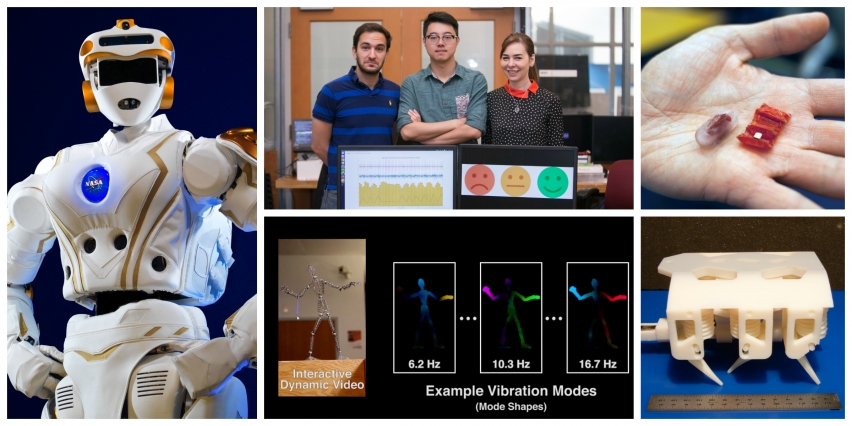
Robohub.org
Ingestible robots, glasses-free 3-D, and computers that explain themselves

In 2016, MIT CSAIL researchers worked on a range of projects in robotics, theory, wireless technology, software systems, and other disciplines. Image: CSAIL
Machines that predict the future, robots that patch wounds and wireless emotion-detectors are just a few of the exciting projects that came out of MIT’s Computer Science and Artificial Intelligence Laboratory (CSAIL) this year. Here’s a sampling of 16 highlights from 2016 that span the many computer science disciplines that make up CSAIL.
Robots for exploring Mars — and your stomach
- A team led by CSAIL director Daniela Rus developed an ingestible origami robot that unfolds in the stomach to patch wounds and remove swallowed batteries.
- Researchers are working on NASA’s humanoid robot, “Valkyrie,” who will be programmed for trips into outer space and to autonomously perform tasks.
- A 3-D printed robot was made of both solids and liquids and printed in one single step, with no assembly required.
Keeping data safe and secure
- CSAIL hosted a cyber summit that convened members of academia, industry, and government, including featured speakers Admiral Michael Rogers, director of the National Security Agency; and Andrew McCabe, deputy director of the Federal Bureau of Investigation.
- Researchers came up with a system for staying anonymous online that uses less bandwidth to transfer large files between anonymous users.
- A deep-learning system called AI2 was shown to be able to predict 85 percent of cyberattacks with the help of some human input.
Advancements in computer vision
- A new imaging technique called Interactive Dynamic Video lets you reach in and “touch” objects in videos using a normal camera.
- Researchers from CSAIL and Israel’s Weizmann Institute of Science produced a movie display called Cinema 3D that uses special lenses and mirrors to allow viewers to watch 3-D movies in a theater without having to wear those clunky 3-D glasses.
- A new deep-learning algorithm can predict human interactions more accurately than ever before, by training itself on footage from TV shows like “Desperate Housewives” and “The Office.”
- A group from MIT and Harvard University developed an algorithm that may help astronomers produce the first image of a black hole, stitching together telescope data to essentially turn the planet into one large telescope dish.
Tech to help with health
- A team produced a robot that can help schedule and assign tasks by learning from humans, in fields like medicine and the military.
- Researchers came up with an algorithm for identifying organs in fetal MRI scans to extensively evaluate prenatal health.
- A wireless device called EQ-Radio can tell if you’re excited, happy, angry, or sad, by measuring breathing and heart rhythms.
Algorithms, systems and networks
- A system called “Polaris” was found to load web pages 34 percent faster by decreasing network trips.
- A team analyzed ant-colony behavior to create better algorithms for network communication, for applications such as social networks and collective decision-making among robot swarms.
- Researchers trained neural networks to explain themselves by providing rationales for their decisions.
tags: algorithms, c-Research-Innovation, Computer Science and Artificial Intelligence Laboratory (CSAIL), Computer science and technology, computer vision, Electrical Engineering & Computer Science (eecs), Research, robotics, School of Engineering, wireless

CSAIL MIT
The Computer Science and Artificial Intelligence Laboratory – known as CSAIL – is the largest research laboratory at MIT and one of the world’s most important centers of information technology research.

CSAIL MIT
The Computer Science and Artificial Intelligence Laboratory – known as CSAIL – is the largest research laboratory at MIT and one of the world’s most important centers of information technology research.
Related posts :
Robot Talk Episode 137 – Getting two-legged robots moving, with Oluwami Dosunmu-Ogunbi
Robot Talk
12 Dec 2025
In the latest episode of the Robot Talk podcast, Claire chatted to Oluwami Dosunmu-Ogunbi from Ohio Northern University about bipedal robots that can walk and even climb stairs.
Radboud chemists are working with companies and robots on the transition from oil-based to bio-based materials
Radboud University
10 Dec 2025
The search for new materials can be accelerated by using robots and AI models.
Generations in Dialogue: Embodied AI, robotics, perception, and action with Professor Roberto Martín-Martín
Catch the latest podcast in the new series from AAAI.
Robot Talk Episode 136 – Making driverless vehicles smarter, with Shimon Whiteson
Robot Talk
05 Dec 2025
In the latest episode of the Robot Talk podcast, Claire chatted to Shimon Whiteson from Waymo about machine learning for autonomous vehicles.
Teaching robot policies without new demonstrations: interview with Jiahui Zhang and Jesse Zhang
Lucy Smith
04 Dec 2025
Hear from authors of work presented at CoRL 2025.
Why companies don’t share AV crash data – and how they could
Cornell University
01 Dec 2025
Researchers have created a roadmap outlining the barriers and opportunities to encourage AV companies to share the data to make AVs safer.
Robot Talk Episode 135 – Robot anatomy and design, with Chapa Sirithunge
Robot Talk
28 Nov 2025
In the latest episode of the Robot Talk podcast, Claire chatted to Chapa Sirithunge from University of Cambridge about what robots can teach us about human anatomy, and vice versa.
Learning robust controllers that work across many partially observable environments
Maris Galesloot
27 Nov 2025
Exploring designing controllers that perform reliably even when the environment may not be precisely known.


